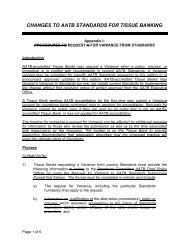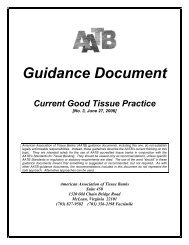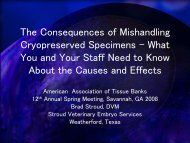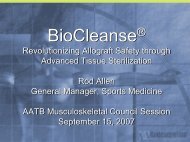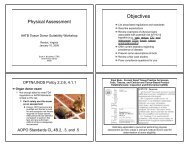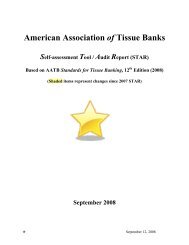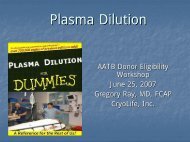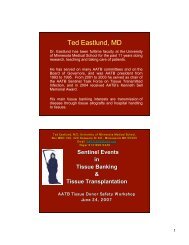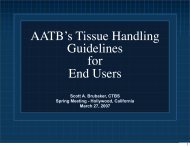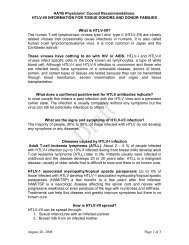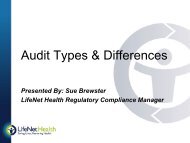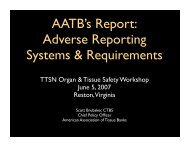changes to aatb standards for tissue banking - American Association ...
changes to aatb standards for tissue banking - American Association ...
changes to aatb standards for tissue banking - American Association ...
You also want an ePaper? Increase the reach of your titles
YUMPU automatically turns print PDFs into web optimized ePapers that Google loves.
CHANGES TO AATB STANDARDS FOR TISSUE BANKING<br />
Appendix II:<br />
CRITERIA FOR PREVENTING TRANSMISSION of RCDADs (Relevant Communicable<br />
Disease Agents and Diseases) 1 THROUGH TRANSPLANTATION OF HUMAN CELLS<br />
and/or TISSUE<br />
Behavior/His<strong>to</strong>ry Exclusionary Criteria<br />
1) Men who have had sex with another man within the preceding five years;<br />
2) Persons who have injected drugs <strong>for</strong> a non-medical reason in the preceding five years,<br />
including intravenous, intramuscular, and subcutaneous injections;<br />
3) Persons with hemophilia or related clotting disorders who have received human-derived<br />
clotting fac<strong>to</strong>r concentrates in the preceding five years;<br />
4) Persons who have had sex in exchange <strong>for</strong> money or drugs in the preceding five years;<br />
5) Persons who have had sex in the preceding 12 months with any person described in the 4<br />
items above or with any person who has HIV infection, including a positive test <strong>for</strong> HIV,<br />
hepatitis B infection, or clinically active (symp<strong>to</strong>matic) hepatitis C 2 infection;<br />
6) Persons who have been exposed within the preceding 12 months <strong>to</strong> known or suspected HIV,<br />
HBV, and/or HCV infected blood through percutaneous inoculation (e.g., needlestick) or<br />
through contact with an open wound, non-intact skin, or mucous membrane;<br />
7) Children born <strong>to</strong> mothers known <strong>to</strong> be HIV-infected or at risk <strong>for</strong> HIV infection, who are 18<br />
months of age or less and/or have been breastfed in the preceding 12 months, regardless of<br />
the child’s (donor’s) HIV status;<br />
NOTE: Children over 18 months of age born <strong>to</strong> mothers infected with HIV or at risk <strong>for</strong><br />
infection, who have not been breast fed within the preceding 12 months, and whose HIV<br />
antibody test, Physical Examination, and review of medical records do not indicate evidence<br />
of HIV infection, may be accepted as donors.<br />
8) Current inmates of correctional systems (including Persons who have been in juvenile<br />
detention, lockup, jails and or prisons) and individuals who have been incarcerated <strong>for</strong> more<br />
than 72 consecutive hours during the previous in the preceding 12 months;<br />
9) Persons with a generic his<strong>to</strong>ry of hepatitis of an unspecified etiology or a current or past<br />
diagnosis of clinical, symp<strong>to</strong>matic viral hepatitis unless evidence from the time of illness<br />
Page 1 of 5
documents that the hepatitis was diagnosed as either hepatitis A or due <strong>to</strong> cy<strong>to</strong>megalovirus or<br />
Epstein-Barr virus hepatitis. (Note: A verbal his<strong>to</strong>ry of viral hepatitis occurring be<strong>for</strong>e the<br />
age of 11 years is acceptable);<br />
10) Persons who have lived with (resided in the same dwelling) another person having viral<br />
hepatitis, except <strong>for</strong> asymp<strong>to</strong>matic hepatitis C, within who has hepatitis B or clinically active<br />
(symp<strong>to</strong>matic) hepatitis C infection in the preceding 12 months preceding donation;”<br />
11) Persons who had or have been treated <strong>for</strong> syphilis or gonorrhea during the preceding 12<br />
months. Donors may be acceptable if evidence is presented that the treatment occurred more<br />
than 12 months ago and was successful;<br />
12) Persons who within 12 months prior <strong>to</strong> donation have undergone tat<strong>to</strong>oing, acupuncture, ear<br />
or body piercing in which shared instruments are known <strong>to</strong> have been used;<br />
13) Persons with a diagnosis of any <strong>for</strong>m of Creutzfeldt-Jakob disease (CJD) or known family<br />
his<strong>to</strong>ry (blood relative) of a person with non-iatrogenic CJD;<br />
14) Persons with a diagnosis of dementia or any degenerative or demyelinating disease of the<br />
central nervous system (CNS) or other neurological disease of unknown etiology. Note: Cells<br />
and/or <strong>tissue</strong>s from donors with dementia, confirmed by gross and microscopic examination<br />
of the brain <strong>to</strong> be caused by cerebrovascular accident, brain tumor, head trauma, or<br />
<strong>to</strong>xic/metabolic dementia and who are confirmed not <strong>to</strong> have evidence of TSE on<br />
microscopic examination of the brain, may be acceptable based on an evaluation of this<br />
in<strong>for</strong>mation by the Medical Direc<strong>to</strong>r.);<br />
15) Persons who have received injections of human pituitary-derived growth hormone (pithGH);<br />
16) Persons who are known <strong>to</strong> have received transplants of human Dura Mater;<br />
17) Persons with encephalitis or meningitis of viral or unknown etiology that is active;<br />
18) Persons who have received transfusions of blood or blood products outside of the United<br />
States during specific time periods in the following countries:<br />
a. From 1980 <strong>to</strong> present: France or the United Kingdom (includes England, Northern<br />
Ireland, Scotland, Wales, the Isle of Man, the Channel Islands, Gibraltar, and the<br />
Falkland Islands); and/or<br />
b. After 1977 <strong>to</strong> present: Central or west Africa (includes Cameroon, Central African<br />
Republic, Chad, Congo, Equa<strong>to</strong>rial Guinea, Gabon, Niger, or Nigeria) 3 ;<br />
19) Persons determined <strong>to</strong> be at risk <strong>for</strong> variant CJD (vCJD) because they are known <strong>to</strong> meet any<br />
of the following criteria:<br />
a. Spent three months or more cumulatively in the United Kingdom (U.K) from the<br />
beginning of 1980 through the end of 1996;<br />
b. Lived cumulatively <strong>for</strong> 5 years or more in Europe 34 from 1980 until the present (note this<br />
criterion includes time spent in the U.K. from 1980 through 1996); and/or<br />
Page 2 of 5
c. Is a current or <strong>for</strong>mer U.S. military member, civilian military employee, or dependent of<br />
a military member or civilian employee who resided at U.S. military bases in Northern<br />
Europe (Germany, U.K., Belgium, and the Netherlands) <strong>for</strong> 6 months or more from 1980<br />
through 1990, or elsewhere in Europe (Greece, Turkey, Spain, Portugal, and Italy) <strong>for</strong> 6<br />
months or more from 1980 through 1996;<br />
20) Persons who, within the previous 120 days, have been <strong>to</strong>ld by a healthcare professional that<br />
they were suspected or known <strong>to</strong> have had a West Nile Virus (WNV) infection based on<br />
symp<strong>to</strong>ms, and/or those who are known <strong>to</strong> have tested positive <strong>for</strong> WNV by a NAT assay<br />
within this time frame, whichever applies;<br />
21) Persons who are known <strong>to</strong> have risks associated with xenotransplantation 45 (i.e. receipt of a<br />
xenotransplantation product 56 or who has had intimate contact 67 with a Recipient of a<br />
xenotransplantation product);<br />
22) Persons who have been permanently deferred as a blood donor <strong>for</strong> unknown reasons or who<br />
have a his<strong>to</strong>ry of positive infectious disease test results <strong>for</strong> HIV, HBV, or HCV;<br />
23) Persons who, within the past six months, were bitten by an animal suspected <strong>to</strong> be infected<br />
with rabies. Individuals with suspected rabies shall not be accepted as donors under any<br />
circumstances (see Title 10 of New York Codes, Rules and Regulations, Section 52-3.4);<br />
24) Persons who have known or suspected sepsis at the time of death, or at the time of donation<br />
in the case of a Living Donor;<br />
25) Persons who, when there is a known person-<strong>to</strong>-person transmission of Severe Acute<br />
Respira<strong>to</strong>ry Syndrome (SARS) CoV occurring in the world:<br />
a. have been diagnosed with SARS or are suspected <strong>to</strong> have SARS within the preceding 28<br />
days,<br />
b. have been determined <strong>to</strong> have had close contact 7 , with someone who has been diagnosed<br />
with SARS or who is suspected of having SARS, within 14 days after last exposure, even<br />
if asymp<strong>to</strong>matic during this time; and/or,<br />
c. have traveled <strong>to</strong> or resided in areas affected by SARS within 14 days of death (or donation<br />
if a Living Donor);<br />
25) Persons who, since 1977, were born in or have lived in any area of central or west Africa<br />
(includes Cameroon, Central African Republic, Chad, Congo, Equa<strong>to</strong>rial Guinea, Gabon,<br />
Niger, and Nigeria) and persons known <strong>to</strong> have had sexual contact with any such person 3 ;<br />
26) Persons who have had a recent smallpox vaccination (vaccinia virus) and persons who<br />
acquired a clinically recognizable vaccinia virus infection by close contact 8 with someone<br />
who received the smallpox vaccine;<br />
27) Persons whose cause of death (COD) cannot be determined and there is likelihood of other<br />
exclusionary criteria; and<br />
28) Persons who are known <strong>to</strong> have malaria or be at risk <strong>for</strong> malaria; and<br />
Page 3 of 5
29) Reproductive donors who have had or have been treated <strong>for</strong> Chlamydia trachomatis or<br />
Neisseria gonorrhea infection in the preceding 12 months. If infection and treatment<br />
occurred more than 12 months ago, evidence of successful treatment such as a negative test<br />
result, must be documented.<br />
1 RELEVANT COMMUNICABLE DISEASE AGENT OR DISEASE (RCDAD) – a potentially<br />
infectious Microorganism, virus, or other disease agent that may pose a risk of transmission <strong>to</strong><br />
Recipients of, or those who come in contact with, cells and/or <strong>tissue</strong>s. These disease<br />
agents/diseases: have sufficient incidence and/or prevalence <strong>to</strong> affect the potential donor<br />
population; could be fatal, life-threatening, result in permanent impairment, or necessitate<br />
medical or surgical intervention <strong>to</strong> preclude permanent impairment; and, <strong>for</strong> which appropriate<br />
screening measures have been developed or an appropriate screening test <strong>for</strong> donor specimens<br />
has been cleared, approved, or FDA-licensed, and is available. They can also be those disease<br />
agents or diseases that could place potential donors and/or Recipients at risk <strong>for</strong> infection due <strong>to</strong><br />
accidental or intentional release. RCDADs applicable <strong>to</strong> all cell and/or <strong>tissue</strong> donors are (but are<br />
not limited <strong>to</strong>): HIV 1/2, HBV, HCV, human TSE, syphilis, communicable disease risks<br />
associated with xenotransplantation, SARS (when applicable), WNV, vaccinia, and sepsis.<br />
Donors of viable, leukocyte-rich cells and/or <strong>tissue</strong>s must additionally consider HTLV I/II, and<br />
donors of reproductive cells and/or <strong>tissue</strong>s must generally consider Chlamydia trachomatis and<br />
Neisseria gonorrhea.<br />
2 CLINICALLY ACTIVE HEPATITIS C - infection with hepatitis C virus when it is<br />
symp<strong>to</strong>matic. This means that: the person demonstrates related symp<strong>to</strong>ms such as jaundice,<br />
icterus, fatigue, abdominal pain, loss of appetite, nausea, vomiting, diarrhea, low grade fever,<br />
headache, joint pain, and/or "flu-like symp<strong>to</strong>ms" AND, HCV infection is suspected or has been<br />
diagnosed or anti-HCV (EIA) testing is positive. Also, knowledge of a recent/current positive<br />
test <strong>for</strong> HCV NAT would qualify as a clinically active HCV infection.<br />
3 Tissue Banks using an HIV test that has been approved by FDA <strong>to</strong> include a donor screening<br />
claim <strong>for</strong> detection of HIV Group O antibodies are not required <strong>to</strong> screen <strong>for</strong> this risk his<strong>to</strong>ry.<br />
34 European countries <strong>to</strong> be used <strong>for</strong> deferral of donors based on geographic risk of Bovine<br />
Spongi<strong>for</strong>m Encephalopathy (BSE): Albania, Austria, Belgium, Bosnia-Herzegovina, Bulgaria,<br />
Croatia, Czech Republic, Denmark, Finland, France, Germany, Greece, Hungary, Ireland, Italy,<br />
Liechtenstein, Luxembourg, Macedonia, Netherlands, Norway, Poland, Portugal, Romania,<br />
Slovak Republic, Slovenia, Spain, Sweden, Switzerland, United Kingdom, and Yugoslavia.<br />
45 XENOTRANSPLANTATION – any procedure that involves the transplantation, implantation,<br />
or infusion in<strong>to</strong> a human recipient of either: (1) live cells, <strong>tissue</strong>s, or organs from a nonhuman<br />
animal source; or (2) human body fluids, cells, <strong>tissue</strong>s, or organs that have had ex vivo contact<br />
with live nonhuman animal cells, <strong>tissue</strong>s, or organs.<br />
56 XENOTRANSPLANTATION PRODUCT – live cells, <strong>tissue</strong>s, or organs used in<br />
xenotransplantation. Biological products, drugs, or medical devices sourced from nonliving<br />
cells, <strong>tissue</strong>s, or organs from nonhuman animals, including but not limited <strong>to</strong> porcine insulin and<br />
porcine heart valves, are not considered xenotransplantation products.<br />
Page 4 of 5
67 XENOTRANSPLANTATION INTIMATE CONTACT: An ‘‘intimate contact of a<br />
xenotransplantation product recipient’’ is a person who has engaged in activities that could result<br />
in the intimate exchange of body fluids with a xenotransplantation product recipient. Examples<br />
of intimate contacts include, but are not limited <strong>to</strong>, sexual partners, household members who<br />
share razors or <strong>to</strong>othbrushes, and health care workers or labora<strong>to</strong>ry personnel with repeated<br />
percutaneous, mucosal, or other direct exposures. Mere sharing of domicile or casual contact,<br />
such as hugging or kissing without the exchange of saliva, would not be interpreted as intimate<br />
contact.<br />
7 CLOSE CONTACT: SEVERE ACUTE RESPIRATORY SYNDROME (SARS): Having cared<br />
<strong>for</strong>, lived with, or having had direct contact with respira<strong>to</strong>ry secretions and/or body fluids of a<br />
patient known <strong>to</strong> be a suspect SARS case.<br />
8 CLOSE CONTACT: SMALLPOX - Physical contact with the vaccination site, <strong>to</strong>uching the<br />
bandages or covering of the vaccination site, or handling bedding or clothing that had been in<br />
contact with an un-bandaged vaccination site.<br />
Sources:<br />
U.S. Department of Health and Human Services, Food and Drug Administration, Eligibility<br />
Determination <strong>for</strong> Donors of Human Cells, Tissues, and Cellular and Tissue-Based Products;<br />
Final Rule (69 FR 29785, May 25, 2004) http://www.fda.gov/cber/rules/suitdonor.pdf<br />
U.S. Department of Health and Human Services, Food and Drug Administration, Draft Final<br />
Guidance <strong>for</strong> Industry: Eligibility Determination <strong>for</strong> Donors of Human Cells, Tissues, and<br />
Cellular and Tissue-Based Products (HCT/Ps) dated May 2004 August 8, 2007.<br />
http://www.fda.gov/cber/gdlns/tissdonor.pdf<br />
U.S. Department of Health and Human Services, Food and Drug Administration, Draft Guidance<br />
<strong>for</strong> Industry: Preventive Measures <strong>to</strong> Reduce the Possible Risk of Transmission of Creutzfeldt-<br />
Jakob Disease (CJD) and Variant Creutzfeldt-Jakob Disease (vCJD) by Human Cells, Tissues,<br />
and Cellular and Tissue-Based Products (HCT/Ps) dated June 2002.<br />
http://www.fda.gov/cber/gdlns/cjdvcjd0602.pdf<br />
U.S. Department of Health and Human Services, Food and Drug Administration, Draft Guidance<br />
<strong>for</strong> Industry: Recommendations <strong>for</strong> Donor Questioning Regarding Possible Exposure <strong>to</strong> Malaria<br />
dated June 2000. http://www.fda.gov/cber/gdlns/malaria.pdf<br />
Published date: November 6, 2007 (AATB Bulletin No. 07-59)<br />
Effective date: February 4, 2008 (in 90 days)<br />
Page 5 of 5



